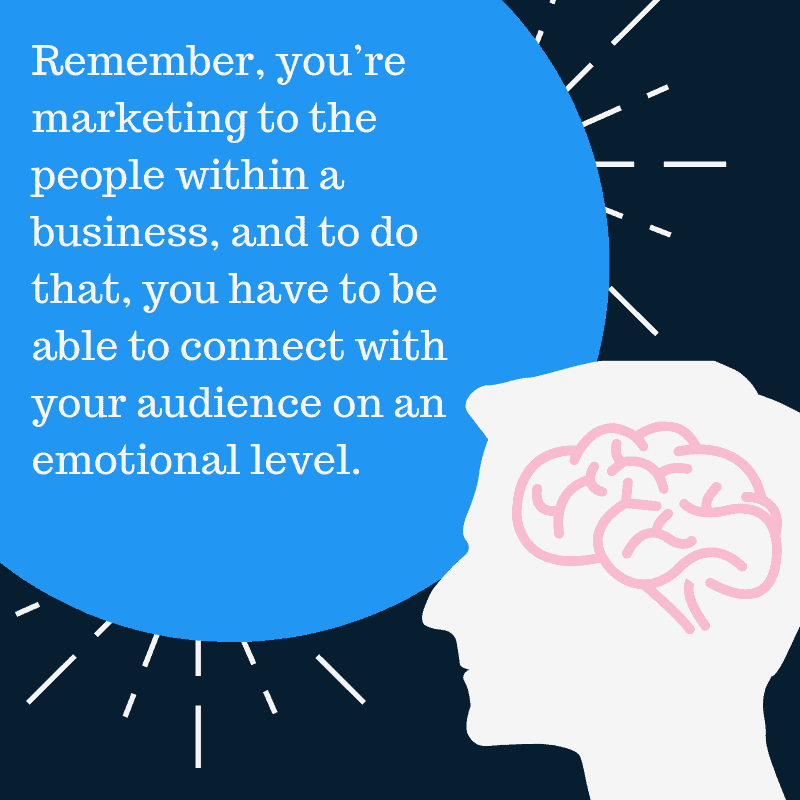I’d like to take you where only a few neuroscientists and psychologists have dared to go before: deep into the minds that make up a B2B decision making unit.
Because of the complexity of the B2B buying cycle, decision makers typically make their decisions as a group. It’s a tall order for B2B marketers: motivate and educate not just one buyer but on average, almost ten (and often even more). Fortunately, despite the size of B2B buying groups, the strategy is still the same—address your audience individually.
In light of this, I’ll be breaking apart that buying group and looking into the mind of an individual decision maker. By understanding each person’s mentality before they go into the group setting to make the final choice enables us to better equip them to make the right decisions—hopefully your offering.
Entering the B2B Decision Making Unit
For this voyage, we’ll travel to the frontal lobe, more specifically the prefrontal cortex, of our decision maker’s mind.
If you are wondering why the frontal lobe sounds so familiar, it’s probably because you remember the story of Phineas Gage from your Psychology 101 class. After a terrible accident—an iron rod through his head—researchers learned that the prefrontal cortex plays a major role in higher cognitive functions that we marketers spend our entire careers trying to influence: emotional processing, problem-solving, and decision making.
Every day the decision maker is faced with hundreds to thousands of decisions that they must make. Especially in today’s digital age, there’s a ton of content trying to steal the decision maker’s attention. To combat the overwhelming amount of information, their mind has created a few shortcuts to make speedier decisions. These shortcuts are called heuristics.
3 Ways Heuristics Impact the Decision Maker’s Choices
The types of decision-making heuristics this decision maker’s mind uses are availability, representativeness, and affect. Let’s dive deeper into what each of these heuristics is and how they impact our decision maker’s thought process.
1. Make Your Brand Available
The availability heuristic is the idea that things which come more easily to mind are more important and common. It’s easily influenced by the media our decision maker is commonly exposed to.
You can see this play out with media coverage surrounding shark attacks. The news and movies make it seem like they’re a lot more likely than they truly are. Because of this, our decision maker is more likely to think of and fear shark attacks every time they go to the beach.
In B2B marketing, we aren’t trying to make people afraid of swimming in the ocean, but we are trying to make our offering seem the obvious choice to a buyer. Of course, wide and continual coverage is the key lesson we can take away from that example.
To be important in your decision maker’s mind, you don’t need more technology, or more channels, or even more content. Rather, you need content targeted to impact your key decision makers, distributed in channels where they already are.
For example, we at Kapost are marketing to fellow marketers (hey, you!). And while empowering content creators to make better content is a huge part of our mission, we know that content creators typically don’t have the power to mobilize their company to adopt a content operation, which is our true offering. Instead of solely providing content for creators, we must strive to engage the marketing leaders who can truly mobilize their teams to make changes and buying decisions.
So—who is your high influence target buyer? Meet them where they’re at, and give them the content to educate
This will help your company’s solution be readily available for the decision maker’s mind to pull up when they’re faced with a decision to make. The easier your brand comes to mind, the more likely it will be that the decision maker will deem it more important than a competitor.
So, go to events, be on social, and use influencer marketing to share your content widely. Basically, be on every corner—the Starbucks of your field.
2. Represent Your Brand Through Storytelling
The representative heuristic is when the decision maker estimates the chance of something happening by comparing it to a typical example they already have in their mind. This heuristic ignores logic and encourages the decision maker to follow their gut. Just because something is representative doesn’t mean its occurrence is more probable.
Consider this: if I were to describe a woman named Sarah as quiet, extremely organized, and a bookworm, then asked our decision maker to guess if she was a salesperson or a librarian. What would they guess?
If they were to use the representative heuristic as a shortcut to answer this question, they may guess that Sarah is a librarian because her characteristics fit more with the typical example they have of a librarian.
If they were to answer with using pure logic, they should guess salesperson because statically there are more salespeople in the workforce than librarians. It’s more likely that Sarah would be a salesperson.
This heuristic shows that our decision maker isn’t as rational as may assume. When creating content for your decision makers think more than just facts and numbers. Use content as a way to tell a story. Storytelling provides marketers with a way to engage the decision maker’s mind and to humanize their brand. Stories provide the context needed to connect the dots of all the facts and allow for humanization of your brand.
According to Ardath Albee, stories are even more powerful when they aren’t about your company but instead, about your customers. Telling stories about your customers lets your decision maker know that you care deeply about people. This raises the decision maker’s confidence in choosing your company to solve their problems.
3. Use Emotions to Connect
The affect heuristic is the way people’s emotions play into their decision-making process. Studies have found that the more positive someone’s mood is, the more likely they are to see lower risk and greater benefits, while someone with a negative mood is more likely to see the decision as riskier and having fewer benefits.
This can be seen when a child waits until their parent is in a good mood before asking to go spend the night at a friends house. Let’s be honest: We’ve all done this in some form or another.
As marketers, it’s our job to use content to convince decision makers to take a chance on our company’s solution. To do this, it’s important to put the decision maker in a good mood. Logic and stats alone won’t make the sale. Just because you work in B2B marketing doesn’t mean you can’t have fun. Good vibes and laughter go a long way. Don’t be afraid to use gifs, jokes, and puns to lighten the mood.

Now, if you want to connect on a deeper level than humor can provide then appeal to the decision maker by painting a clear picture of the solution you can provide for them. When you show them a solution specific to their problem it makes them feel heard and understood.
Remember, you’re marketing to the people within a B2B decision making unit, and to do that, you have to be able to connect with your audience on an emotional level.
Prepare for the Conclusion
We’re coming to the end of our voyage through the decision maker’s prefrontal cortex. Inside, the decision maker’s mind is not as dark and mysterious as some assume. They aren’t cold, purely logical beings. They use shortcuts to make life easier for them and those around them.
Each and every member of the B2B decision making unit values their time above most other things, and we as marketers need to respect that by applying what we know about how their mind makes shortcuts for decisions.
Some takeaways: When trying to sway the decision maker, make sure you’re where your decision makers are, whether it be at events or on social media. Don’t only share statistics; play into their illogical, gut-decision-making side through storytelling. Last but not least, find a way to connect with them on an emotional level through laughter and listening.
As we prepare for the end of the blog please make sure to use caution when unloading items from the overhead bins as items may have shifted during our trip. On behalf of the Marketeer and everyone at Kapost, I’d like to thank you for joining us on this trip into the decision maker’s mind. As you disembark this blog, don’t forget to subscribe to our newsletter to keep the journey going.



